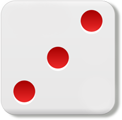Two dice game II
This task is about predicting, then recording, the outcome of a game of chance.
|
How to do this task
When two dice are thrown you can multiply the two numbers together to get a product.   Example: 3 x 5 = 15 |
|
| a) |
Predict the probability that the product of the two top numbers on the dice is less than 10 (i.e., 1-9) __________
|
| b) |
Now throw two dice yourself.
On the tally chart below, record whether the product of the two top numbers on the dice is less than 10, or 10 or more.
Repeat this 100 times altogether.
|
|
|
c)
|
Use your results in b) to work out the probability of the product being less than 10. __________
|
| d) |
Comment on how accurate your prediction was.
|


 ) or some other
) or some other  .
.